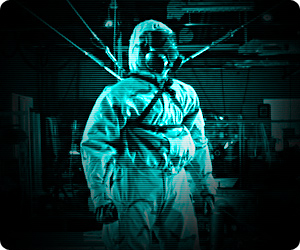 DARPA Begins Building Skynet And Its Robots With ‘Real’ Brains
DARPA Begins Building Skynet And Its Robots With ‘Real’ Brains
The next frontier for the robotics industry is to build machines that think like humans. Scientists have pursued that elusive goal for decades, and they believe they are now just inches away from the finish line. A Pentagon-funded team of researchers has constructed a tiny machine that would allow robots to act independently. Unlike traditional artificial intelligence systems that rely on conventional computer programming, this one “looks and ‘thinks’ like a human brain,” said James K. Gimzewski, professor of chemistry at the . Gimsewski is a member of the team that has been working under sponsorship of the Defense Advanced Research Projects Agency on a program called “physical intelligence.” This technology could be the secret to making robots that are truly autonomous, Gimsewski said during a conference call hosted by Technolink, a -based industry group. This project does not use standard robot hardware with integrated circuitry, he said. The device that his team constructed is capable, without being programmed like a traditional robot, of performing actions similar to humans, Gimsewski said.
 Next Generation Biometrics To UseBrain Waves
Next Generation Biometrics To UseBrain Waves
There are many different solutions coming to market aiming to make secure Web and computer login easy and secure. Biometrics have been considered and deployed but adoption right out of science fiction is emerging that would authenticate via brain waves. Students and a professor at the University of California Berkley School of Information is working on a system that would have a user wear a headset equipped with electroencephalograms – EEGs – to measure brain wave activity. Using brain waves for identification is not a new idea but the technology used to read those brainwaves is new, according to a release from the UC School of information. “Traditional clinical EEGs typically employ dense arrays of electrodes to record 32, 64, 128, or 256 channels of EEG data. But new consumer-grade headsets use just a single dry-contact sensor resting against the user’s forehead, providing a single-channel EEG signal from the brain’s left frontal lobe,” the release states.
Are We Paying Enough Attention To Information Technology’s Dark Side?
For centuries, the threat and selective use of brute force has steered the international balance of power. In the last couple decades, the system has increasingly accommodated economic power as a means of non-violent leverage between states. Now, says ’s Marc Goodman, we must add technology into the mix. Technological power is not new, of course, but information technology’s exponential pace and declining cost is changing how the global game is played and who the players are. Control of technology is passing from the richest states and governments to smaller groups and individuals, and the results are both inspiring and terrifying. As Goodman says, “The ability of one to affect many is scaling exponentially—and it’s scaling for good and it’s scaling for evil.”

Meet Your Future Enemy: Pentagon Developing Humanoid Terminator Robots That Will Soon Carry Weapons
Have no illusions about where this is headed: wants to develop and deploy a robotic army of autonomous soldiers that will kill without hesitation. It’s only a matter of time before these robots are armed with rifles, grenade launchers and more. Their target acquisition systems can be a hybrid combination of both thermal and night vision technologies, allowing them to see humans at night and even detect heat signatures through building walls. This is the army humanity is eventually going to face. You’d all better start getting familiar with the anatomy of humanoid robots so that you know where to shoot them for maximum incapacitation effect. You’d also better start learning how to sew thermal blankets into clothing, hoodies and scarves in order to fool thermal imaging systems.


